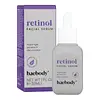What's inside
What's inside
 Key Ingredients
Key Ingredients

 Benefits
Benefits

 Concerns
Concerns

 Ingredients Side-by-side
Ingredients Side-by-side

Water
Skin ConditioningIsononyl Isononanoate
EmollientSodium Stearoyl Lactylate
EmulsifyingNiacinamide
SmoothingGlyceryl Caprylate
EmollientGlycine Soja Oil
EmollientCetearyl Olivate
Xanthan Gum
EmulsifyingSodium Acrylate/Sodium Acryloyldimethyl Taurate Copolymer
Emulsion StabilisingSorbitan Olivate
EmulsifyingPisum Sativum Peptide
Skin ConditioningRetinol
Skin ConditioningSodium Hyaluronate
HumectantZingiber Officinale Root Extract
MaskingBisabolol
MaskingSodium Citrate
Buffering1,2-Hexanediol
Skin ConditioningGlyceryl Stearate
EmollientPolyisobutene
Magnesium Stearate
Cosmetic ColorantCetearyl Alcohol
EmollientGlycerin
HumectantEpilobium Angustifolium Flower/Leaf/Stem Extract
Skin ConditioningCaprylhydroxamic Acid
Citric Acid
BufferingTetrasodium Glutamate Diacetate
Caprylyl/Capryl Glucoside
CleansingWater, Isononyl Isononanoate, Sodium Stearoyl Lactylate, Niacinamide, Glyceryl Caprylate, Glycine Soja Oil, Cetearyl Olivate, Xanthan Gum, Sodium Acrylate/Sodium Acryloyldimethyl Taurate Copolymer, Sorbitan Olivate, Pisum Sativum Peptide, Retinol, Sodium Hyaluronate, Zingiber Officinale Root Extract, Bisabolol, Sodium Citrate, 1,2-Hexanediol, Glyceryl Stearate, Polyisobutene, Magnesium Stearate, Cetearyl Alcohol, Glycerin, Epilobium Angustifolium Flower/Leaf/Stem Extract, Caprylhydroxamic Acid, Citric Acid, Tetrasodium Glutamate Diacetate, Caprylyl/Capryl Glucoside
Water
Skin ConditioningAloe Barbadensis Leaf Juice
Skin ConditioningHamamelis Virginiana Water
AstringentGlycerin
HumectantSimmondsia Chinensis Seed Oil
EmollientTriticum Vulgare Germ Oil
EmollientRetinol
Skin ConditioningTocopherol
AntioxidantTocopheryl Acetate
AntioxidantCaesalpinia Spinosa Gum
Skin ConditioningPropolis Extract
Skin ConditioningCentella Asiatica Extract
CleansingEquisetum Arvense Extract
AstringentGeranium Maculatum Extract
TonicTaraxacum Officinale Extract
Skin ConditioningCamellia Sinensis Leaf Extract
AntimicrobialAcrylates/C10-30 Alkyl Acrylate Crosspolymer
Emulsion StabilisingLecithin
EmollientPentylene Glycol
Skin ConditioningPolysorbate 20
EmulsifyingAlcohol
AntimicrobialPotassium Phosphate
BufferingCarrageenan
Hydroxyethylcellulose
Emulsion StabilisingPhenoxyethanol
PreservativeEthylhexylglycerin
Skin ConditioningWater, Aloe Barbadensis Leaf Juice, Hamamelis Virginiana Water, Glycerin, Simmondsia Chinensis Seed Oil, Triticum Vulgare Germ Oil, Retinol, Tocopherol, Tocopheryl Acetate, Caesalpinia Spinosa Gum, Propolis Extract, Centella Asiatica Extract, Equisetum Arvense Extract, Geranium Maculatum Extract, Taraxacum Officinale Extract, Camellia Sinensis Leaf Extract, Acrylates/C10-30 Alkyl Acrylate Crosspolymer, Lecithin, Pentylene Glycol, Polysorbate 20, Alcohol, Potassium Phosphate, Carrageenan, Hydroxyethylcellulose, Phenoxyethanol, Ethylhexylglycerin
Ingredients Explained
These ingredients are found in both products.
Ingredients higher up in an ingredient list are typically present in a larger amount.
Glycerin is already naturally found in your skin. It helps moisturize and protect your skin.
A study from 2016 found glycerin to be more effective as a humectant than AHAs and hyaluronic acid.
As a humectant, it helps the skin stay hydrated by pulling moisture to your skin. The low molecular weight of glycerin allows it to pull moisture into the deeper layers of your skin.
Hydrated skin improves your skin barrier; Your skin barrier helps protect against irritants and bacteria.
Glycerin has also been found to have antimicrobial and antiviral properties. Due to these properties, glycerin is often used in wound and burn treatments.
In cosmetics, glycerin is usually derived from plants such as soybean or palm. However, it can also be sourced from animals, such as tallow or animal fat.
This ingredient is organic, colorless, odorless, and non-toxic.
Glycerin is the name for this ingredient in American English. British English uses Glycerol/Glycerine.
Learn more about GlycerinRetinol is a gold-standard ingredient for anti-aging. It is a form of Vitamin A and belongs to the class of retinoids that also includes tretinoin.
Why is retinol famous?
It has the most scientific studies backing up its skin benefits out of all the non-prescription ingredients.
Retinol is proven to:
This is why retinol is effective at removing wrinkles, fading dark spots, treating acne, and reducing the appearance of pores.
Studies show retinol is less effective when exposed to UV. Be sure to look for appropriate packaging to keep your retinol potent (similar to Vitamin C).
Using retinol or any retinoids will increase sun-sensitivity in the first few months. Though studies show retinoids increase your skin's natural SPF with continuous use, it is best to always wear sunscreen and sun-protection.
We recommend speaking with a medical professional about using this ingredient during pregnancy.
Retinol may cause irritation in some people, so be sure to patch test. Experts recommend 'ramping up' retinol use: start using this ingredient once a week and work up to using it daily.
Read about Tretinoin
Learn more about RetinolWater. It's the most common cosmetic ingredient of all. You'll usually see it at the top of ingredient lists, meaning that it makes up the largest part of the product.
So why is it so popular? Water most often acts as a solvent - this means that it helps dissolve other ingredients into the formulation.
You'll also recognize water as that liquid we all need to stay alive. If you see this, drink a glass of water. Stay hydrated!
Learn more about Water